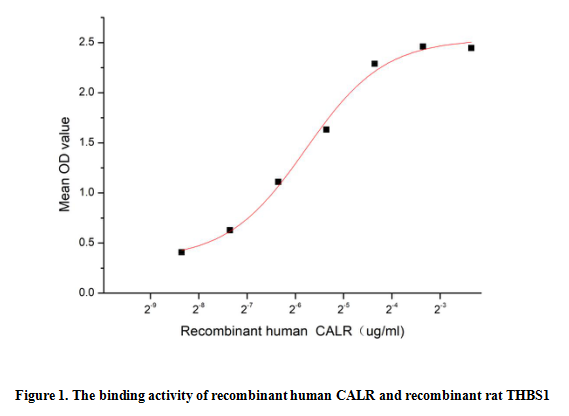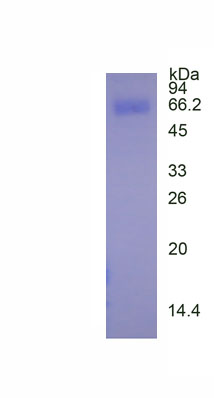Active Calreticulin (CALR) 

CRT; RO; SSA; CC1qR; ERp60; HACBP; grp60; CRTC; CRP55; Calregulin; Sicca Syndrome Antigen A; Autoantigen Ro; Endoplasmic reticulum resident protein 60
- UOM
- FOB US$ 302.00 US$ 756.00 US$ 1,512.00 US$ 4,536.00 US$ 11,340.00
- Quantity
Overview
Properties
- Product No.APB486Hu61
- Organism SpeciesHomo sapiens (Human) Same name, Different species.
- ApplicationsCell culture; Activity Assays.
Research use only - DownloadInstruction Manual
- CategorySignal transductionMetabolic pathwayBone metabolism
- Buffer FormulationPBS, pH7.4, containing 0.01% SKL, 5% Trehalose.
- Traits Freeze-dried powder, Purity > 97%
- Isoelectric Point4.3
Sign into your account
Share a new citation as an author
Upload your experimental result
Review

Contact us
Please fill in the blank.
Activity test

Calreticulin (CALR) is an endoplasmic reticulum (ER)-resident protein involved in a spectrum of cellular processes. In healthy cells, CALR operates as a chaperone and Ca2 buffer to assist correct protein folding within the ER. Calreticulin is also found in the nucleus, suggesting that it may have a role in transcription regulation. Systemic lupus erythematosus is associated with increased autoantibody titers against calreticulin. Recurrent mutations in calreticulin have been linked to various neoplasms, including the myeloproliferative type. Adhesive glycoprotein THBS1 has been shown to play roles in platelet aggregation, angiogenesis and tumorigenesis, the protein is an interactor of CALR, thus a functional binding ELISA assay was conducted to detect the interaction of recombinant human CALR and recombinant rat THBS1. Briefly, biotin-linked CALR were diluted serially in PBS, with 0.01% BSA (pH 7.4). Duplicate samples of 100 ul were then transferred to THBS1-coated microtiter wells and incubated for 1h at 37℃. Wells were washed with PBST 3 times and incubation with Streptavidin-HRP for 30min, then wells were aspirated and washed 5 times. With the addition of substrate solution, wells were incubated 15-25 minutes at 37℃. Finally, add 50 µl stop solution to the wells and read at 450 nm immediately. The binding activity of CALR andTHBS1 was shown in Figure 1, the EC50 for this effect is 0.018 ug/mL.
Usage
Reconstitute in 10mM PBS (pH7.4) to a concentration of 0.1-1.0 mg/mL. Do not vortex.
Storage
Avoid repeated freeze/thaw cycles. Store at 2-8°C for one month. Aliquot and store at -80°C for 12 months.
Stability
The thermal stability is described by the loss rate. The loss rate was determined by accelerated thermal degradation test, that is, incubate the protein at 37°C for 48h, and no obvious degradation and precipitation were observed. The loss rate is less than 5% within the expiration date under appropriate storage condition.
Increment services
-
 BCA Protein Quantification Kit
BCA Protein Quantification Kit
-
 Molecular Mass Marker for Protein
Molecular Mass Marker for Protein
-
 Monoclonal Antibody Customized Service
Monoclonal Antibody Customized Service
-
 Polyclonal Antibody Customized Service
Polyclonal Antibody Customized Service
-
 Protein Activity Test Experiment Service
Protein Activity Test Experiment Service
-
 Electrophoretic Mobility Shift Assay (EMSA) Experiment Service
Electrophoretic Mobility Shift Assay (EMSA) Experiment Service
-
 Buffer
Buffer
-
 Lentivirus Packaging Experiment Service
Lentivirus Packaging Experiment Service
-
 Adenovirus Packaging Experiment Service
Adenovirus Packaging Experiment Service
-
 Real Time PCR Experimental Service
Real Time PCR Experimental Service
-
 Spike RBD Protein (S-RBD)
Spike RBD Protein (S-RBD)
-
 Protein G
Protein G
-
 Protein A
Protein A
Citations
- Oxidative Stress-Induced Calreticulin Expression and Translocation: New Insights into the Destruction of MelanocytesPubmed: 23771121
- The Anticoagulant Effect of PGI2S and tPA in Transgenic Umbilical Vein Endothelial Cells Is Linked to Up-Regulation of PKA and PKCMdpi: Source
- Amniotic fluid calreticulin in pregnancies complicated by the preterm prelabor rupture of membranesPubmed:26953684
- Cervical fluid calreticulin and cathepsin-G in pregnancies complicated by preterm prelabor rupture of membranes.pubmed:28152632
- Investigation of the interaction between calreticulin and immunoglobulin G by capillary electrophoresis and computer modelingDoi: 10.1016/j.talanta.2018.11.098
- Thermostable ionizable lipid-like nanoparticle (iLAND) for RNAi treatment of hyperlipidemiaPubmed:35171673







